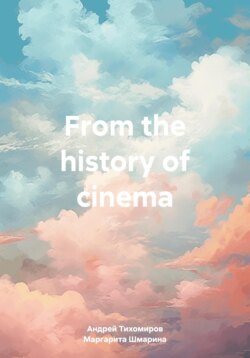
000
ОтложитьЧитал
The team, headed by film director L. V. Kuleshov, acquired great importance at this time. This team formed the work of directors V. I. Pudovkin and B. V. Barnet, actors A. S. Khokhlova, V. P. Vogel and others.
The ideological and artistic development of Soviet cinema was brilliantly expressed in the films directed by S. M. Eisenstein and V. I. Pudovkin. Eisenstein began his work in cinema with the film "Strike" (1925), the first work of Soviet cinema that recreates the image of the revolutionary working masses. Despite the fact that the artistic solution of the picture was influenced by the theories of the "Proletkult", it became an important stage in the development of Soviet cinema. In Eisenstein's next film, The Battleship Potemkin (screenplay by N. F. Agadzhanova, S. M. Eisenstein, cinematographer E. K. Tisset, 1925) the revolutionary theme received a politically profound and artistically passionate embodiment. Depicting with great expressiveness and drama one of the episodes of the 1905 revolution – the uprising on the battleship Potemkin, the film asserted the victorious power of revolutionary ideas, showed the inevitability of the victory of the revolution, and was recognized more than once as one of the best films ever made according to the results of international surveys of critics, film critics and viewers. The truth of life and revolutionary pathos were expressed in this film with the help of innovative visual means. The installation, rhythm, composition, and vivid realistic details served the purpose of creating an image of a struggling people. The Battleship Potemkin had a huge impact on the formation of world cinematography.
An outstanding role in the development of cinematography was played by V. I. Pudovkin's film "Mother" (based on the novel by M. Gorky, screenplay by N. A. Zarkhi, cinematographer A. D. Golovnya, 1926), recreating the events of the first Russian revolution. In 1927, Pudovkin directed the film "The End of St. Petersburg" (screenplay by N. A. Zarkhi, cinematographer A. D. Golovnya), in 1929 – "Descendant of Genghis Khan" (screenplay by O. M. Brik, cinematographer A. D. Golovnya), in which vivid typical images of advanced representatives of the people were created.
In the early 20s, the directors of the older generation, who began their creative career in pre-revolutionary cinema, achieved significant success. The largest of them, Ya. A. Protazanov, created a number of films imbued with love for the common Soviet man, reflecting revolutionary changes in the life of the Motherland (films "His Call", 1925, "Forty—first", 1927, "Don Diego and Pelageya", 1928, etc.).
One of the most significant and successful films of early Russian cinema should be called "The Defense of Sevastopol" (1911) Vasily Goncharov and Alexander Khanzhonkov. The film is a chain of reconstructed events of the defense of Sevastopol during the Crimean War of 1853-1856, possibly following the course of real facts. Although this film is devoid of a plot and an elementary dramatic structure, it makes no sense to make dramatic claims – it is better to simply designate its genre: a reconstructed chronicle, as you and I already know, introduced by Melies. The battle scenes here, apparently, for the first time in the world, were filmed with two cameras using panoramas and camera angles. Regular units of the Russian army and veterans of the battle for Sevastopol from both sides of the front took part in the filming – in the final they appear on the screen. In the original, the film lasted 1 hour and 40 minutes. It was the first Russian and one of the first feature films in the world.
In the 20s, Soviet cinematography was replenished by a large group of young directors.
In 1922, directors G. M. Kozintsev and L. 3. Trauberg created the collective "Factory of the Eccentric Actor" (FEKS) in Petrograd. In the film "New Babylon" (1929), they truthfully showed the events of the Paris Commune on the screen. During these years, director F. M. Ermler worked on modern themes with great success. In the film "The Fragment of the Empire" (1929), directed by Ermler, the meaning of the political conquests of the working class was revealed in a vivid artistic form. In the film "Lace" (1928), director S. I. Yutkevich poetically embodied the features of the new in the life and morals of the Soviet people. Among the best comedies of the late 20s: "The Trial of three Million" (1926) and "Don Diego and Pelageya" (1928) directed by Ya. A. Protazanov, "Two friends, a model and a girlfriend" directed by A.D. Popov (1928), etc. A group of young directors worked successfully in Moscow, among whom were B. V. Barnett, A. M. Room, Y. Ya. Raisman, I. A. Pyriev, G. L. Roshal, E. V. Chervyakov and others. Most of the films they directed reflected the problems of modernity and new morality. The rise of Soviet cinema was closely connected with the formation of a cadre of directors, as well as film dramatists (E. N. Vinogradskaya, G. E. Grebner, S. A. Ermolinsky, N. A. Zarkhi, B. L. Leonidov, O. L. Leonidov, V. K. Turkin, etc.), operators (A. D. Golovnya, D. P. Demutsky, A. N. Moskvin, E. K. Tisset).
Historical and documentary films stand out in the documentary films of these years: "The Fall of the Romanov Dynasty" (1927), "The Great Way" (1927), "Russia of Nicholas II and Leo Tolstoy" (1928) directed by E. I. Shub, the film "Shanghai Document" directed by Ya. I. Blioch (1928) – about the revolutionary struggle of the Chinese people, "Turksib" directed by V. A. Turina (1929) – about the successes of socialist industrialization.
Since 1927, the income from the rental of Soviet films has exceeded the income from the rental of foreign films. The export of Soviet films abroad increased (in 1927, films were sold to 54 countries).



